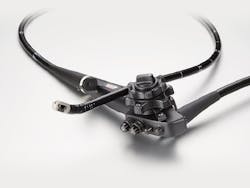FDA recommends newer-designed duodenoscopes for better infection control safety
The U.S. Food and Drug Administration (FDA) is recommending that hospitals and endoscopy facilities transition away from fixed endcap duodenoscopes to those with newer design features that facilitate or eliminate the need for reprocessing, according to their recent statement. Please note, we recognize that a full transition away from conventional duodenoscopes to the newer, innovative models will take time.
Duodenoscopes play a vital role in the assessment and treatment of diseases and conditions of the pancreas and bile ducts, and are used in more than 500,000 endoscopic retrograde cholangiopancreatography (ERCP) procedures each year in the U.S. These devices have complex designs that include reusable, hard-to-clean components. Failure to correctly reprocess a duodenoscope could result in tissue or fluid from one patient remaining in a duodenoscope when it is used on a subsequent patient. In rare cases, this can lead to patient-to-patient disease transmission.
We continue to work with manufacturers to increase the supply of disposable cap duodenoscopes and the development of other new and innovative device designs that will further minimize or eliminate the risk of patient infection. We continue to address challenges with current reprocessing methods and support expanding the types of validated methods available to reprocess duodenoscopes.
Each duodenoscope manufacturer (Fujifilm, Olympus and Pentax) currently marketing in the U.S. was ordered by the FDA to conduct postmarket surveillance studies to determine rates of contamination after clinical use and reprocessing of its fixed endcap duodenoscopes. Fixed endcap duodenoscopes have a plastic or rubber cap permanently glued to the metal edges around the distal end to prevent tissue injury from the metal edges on the scopes, but when permanently affixed, the endcaps also limit the accessibility to clean the crevices at the distal end.
The postmarket surveillance studies were intended to determine the real-world contamination rates for duodenoscopes in clinical use and serve as measures of the effectiveness of reprocessing. We have previously communicated interim study results demonstrating higher than expected levels of contamination. The most recent studies from Fujifilm, Olympus, and Pentax continue to show elevated rates of contamination, including the presence of high concern organisms, defined as organisms that are more often associated with disease transmission, such as E. coli and Pseudomonas aeruginosa.
In addition to the sampling and culturing studies noted above, each duodenoscope manufacturer was ordered to conduct postmarket surveillance studies to evaluate whether staff could understand and follow the manufacturer's reprocessing instructions for use (RIFU) in real-world healthcare settings. Failure to adhere to the RIFU may result in duodenoscope contamination. These studies are called human factors studies. The results from Fujifilm and Olympus, suggest that users frequently had difficulty understanding and following manufacturers' RIFU and as a result, were not able to successfully complete reprocessing. We are continuing to work with manufacturers to conduct additional testing and revise reprocessing manuals, as appropriate.
To date, the FDA has cleared three duodenoscopes with disposable components that facilitate reprocessing:
· Fujifilm Corporation, Duodenoscope model ED-580XT (disposable endcap duodenoscope cleared under K181745)
· Pentax Medical, Duodenoscope model ED34-i10T (disposable endcap duodenoscope cleared under K163614 and K181522)
· Boston Scientific Corporation, EXALT Model D Single-Use Duodenoscope (fully disposable duodenoscope cleared under K193202)
We continue to actively work with reprocessing experts, medical device manufacturers and other government agencies to advance innovative ways to decrease infection related to duodenoscopes.
Since we last shared an update in April 2019, we have taken several actions:
· Including Real-World Contamination Rates in the Labeling
· Exploring the Expansion of Available Validated Methods
· Exploring the Potential for Monitoring Reprocessing Effectiveness
· Planning an FDA Advisory Committee Meeting to Discuss Duodenoscope Reprocessing
· Including Real-World Contamination Rates in the Labeling
During the May 16-17, 2019 public meeting of the Centers for Disease Control Healthcare Infection Control Practices Advisory Committee, the Committee concluded that information on the effectiveness of duodenoscope reprocessing to prevent between-patient contamination should be included in the labeling of duodenoscopes. We have asked duodenoscope manufacturers to include real-world contamination rates in the labeling of all currently marketed fixed endcap duodenoscopes.
We have also ordered the manufacturers of duodenoscopes with disposable endcaps to conduct new postmarket surveillance studies to verify that the new designs reduce the contamination rate. Upon completion of these postmarket surveillance studies, we expect the labeling to be updated with contamination rate data.
We encourage device manufacturers to develop innovative approaches for the entire duodenoscope reprocessing procedure to provide a high margin of safety and reduce the risk of infection associated with reprocessed duodenoscopes. Such approaches may require collaboration among stakeholders, including manufacturers of duodenoscopes and reprocessing devices, to test and validate the use of innovative reprocessing approaches and to demonstrate a relative reduction in infection risk in a real-world setting.
We have also recently announced two challenges for new, innovative sterilization methods. These challenges are intended to advance the science of sterilization with the goal of developing sterilization technologies that are compatible with a variety of medical devices; those advancements may be applied to reusable medical devices like duodenoscopes.





